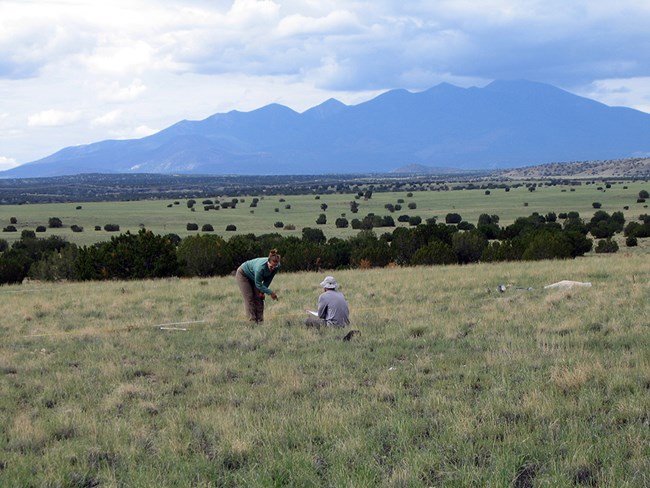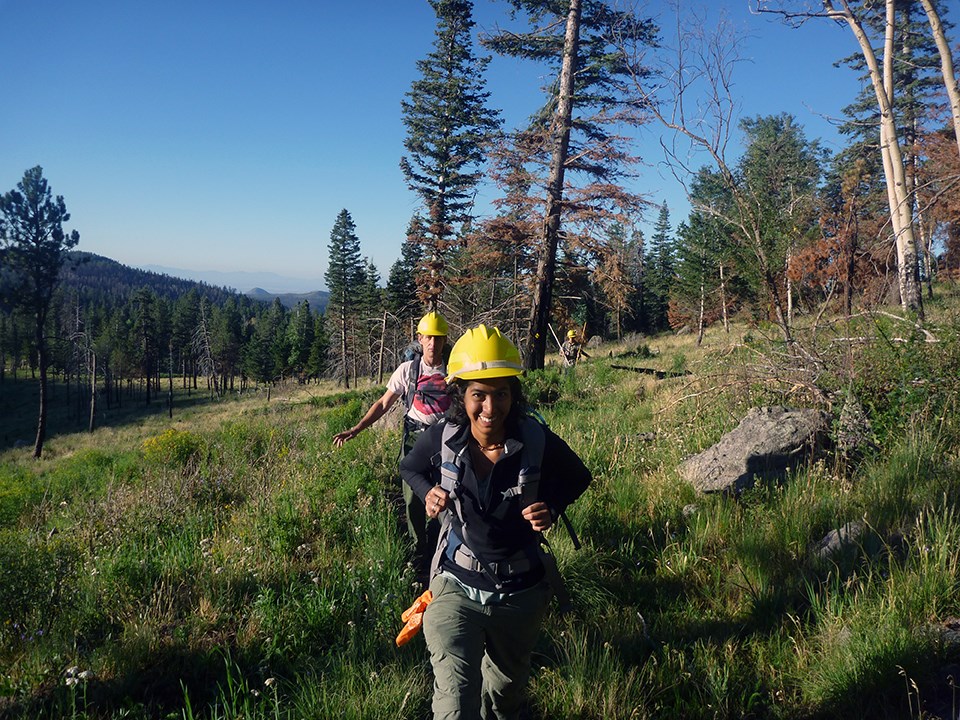
NPS / SCPN
SCPN Monitoring Sites Webmap (NPS staff only)
The Southern Colorado Plateau Network (SCPN) monitors vegetation condition and soil stability in upland ecosystems to track changes in ecosystem integrity. These ecosystems include forests, woodlands, grasslands, and shrublands. They function to conserve soil, sequester carbon, and cycle nutrients, energy, and water.
Long-term vegetation monitoring reveals how plant communities change over time in response to climate, disturbance, and management. Changes in vegetation, in turn, affect habitat quality for resident and migrant animal species. Monitoring soil stability and related hydrologic function provides a direct measure of the threat posed by erosion to these ecosystems.
Both natural and anthropogenic disturbances shape upland ecosystems. Past intensive grazing over much of the Colorado Plateau degraded vegetation conditions, and compacted and eroded soil. While grazing no longer occurs in most SCPN parks and vegetation is recovering, cattle grazing continues in Glen Canyon National Recreation Area in Arizona.
Climate change projections for the Southwest predict warmer temperatures, reduced snowfall and more extreme climatic events. This would exacerbate the role of drought in controlling vegetation dynamics and may increase the spread of invasive exotic plants. Fire regimes are an important driver of Colorado Plateau vegetation dynamics, especially in forested and woodland ecosystems. SCPN works with the National Park Service's Fire Effects Monitoring program to monitor the effects of natural and prescribed wildland fires in network parks. With predicted climate change looming, more frequent and severe wildfires are expected for the Southwest.

NPS / SCPN
Monitoring Objectives
-
Determine the status and trends in species composition and vegetation structure in selected plant communities.
-
Determine the status and trends in soil stability and upland hydrologic function within selected predominant upland ecological sites.
- Determine the relationships between vegetation patterns and soil stability/hydrologic function.
Vital Signs and Metrics
SCPN parks have identified 2 vital signs and associated metrics for this project:
1. Vegetation condition
- Species composition
- Structure
2. Soil stability
Monitored in These Parks and Ecological Sites
An ecological site is defined as a distinctive kind of land with specific soil and physical characteristics that differ from other kinds of land in its ability to produce a distinctive kind and amount of vegetation and its ability to respond similarly to management actions and natural disturbances.
-
Aztec Ruins National Monument - Limy Upland
-
Bandelier National Monument - Mesa Top Pinyon-Juniper
-
Chaco Culture National Historical Park - Sandy Loam Upland
-
El Malpais National Monument - Mountain Malpais
-
Glen Canyon National Recreation Area - Desert Sand
- Grand Canyon National Park - Mixed Conifer, Pinyon-Juniper
- Mesa Verde National Park - Loamy Mesa Top Pinyon-Juniper, Shallow Loamy Mesa Top Pinyon-Juniper
- Petrified Forest National Park - Sandy Loam Upland, Clayey Fan
- Petroglyph National Monument - Malpais
- Walnut Canyon National Monument - Ponderosa Pine
- Wupatki National Monument - Volcanic Upland, Loamy Upland
Monitoring Project Status
Vegetation and soils are monitored annually across a variety of ecological sites in ten SCPN parks (El Malpais National Monument is in development). Integrated upland monitoring began in 2007. The Integrated Upland Monitoring Protocol for the Southern Colorado Plateau Network was published in September 2012.
Project Contact
Megan Swan, Botanist
Reports and Publications
DeCoster, James K., Chris L. Lauver, Mark E. Miller, Jodi R. Norris, Allison E. C. Snyder, Megan C. Swan, Lisa P. Thomas, and Dana L. Witwicki. 2012. Integrated upland monitoring protocol for the Southern Colorado Plateau Network. Natural Resource Report NPS/SCPN/NRR–2012/577. National Park Service, Fort Collins, Colorado.
Source: NPS DataStore Saved Search 5056. To search for additional information, visit the NPS DataStore.
Last updated: February 6, 2025
